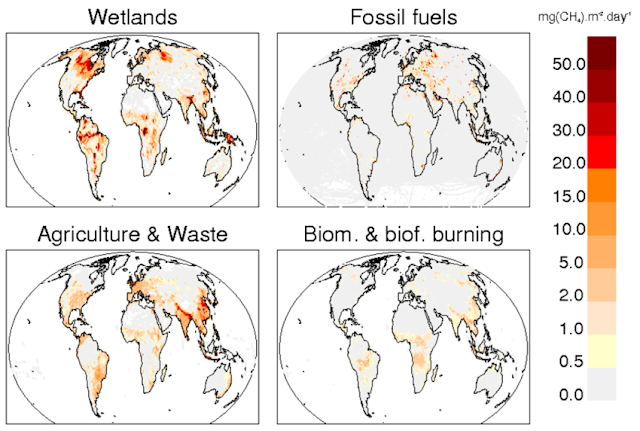The shifting sands of methane sources
In the last 250 years, methane concentrations in
the atmosphere have doubled. This seems like a sign that we should put a bridle
on methane emissions – but where do we start? Understanding
of the methane cycle is essential.
Methane is also taken up by methanotrophic bacteria in oxic soils.
These sources and sinks cause methane to have an atmospheric lifetime of 9.1±0.9 years.
It's important to note that the strength of methane emissions differs regionally (fig. 2). Africa, tropical South America and South East Asia are the heaviest methane-emitters worldwide, due to their agriculture, forests, and savannah and wetland ecosystems.
Last week, we
saw that the isotopic signatures of methane emissions can indicate the contribution of methane sources in the past. Today,
I would like to have a closer look into this cycle and explore the methane molecule's playground.
The many sources of methane emissions are generally divisible into three broad groups: biogenic, thermogenic (also known as geological) and pyrogenic sources. According to researchers from the Global Carbon Project, the annual global source strength of methane was 558 Tg CH4 yr−1 between 2003 and 2012. They are less certain, however, about the contribution of each source and the total anthropogenic contribution (fig. 1).
Biogenic sources
 |
| Figure 1 | The global methane budget averaged over 2003 - 2012. Keep an eye on the numbers within the brackets - the range of estimate for each source is significant. |
Biogenic sources
Biogenicmethane emissions are caused by micro-organisms
called methanogens. These
methanogens produce methane as by-product when situated in oxygen-deficient wet areas, such as wetlands, rice paddies,
and fresh water reservoirs, but also in the gut of termites and ruminants. Organic waste deposits, such as landfills
and sewage, also contain methanogens and belong to the biogenic group. The δ13C signature of
biogenic methane sources lies in the range of -55 to -70‰.
Thermogenic sources
Thermogenic or geological sources release methane from the lithosphere. These sources include anthropogenic fossil fuel burning, but also natural
processes. At a certain depth in the earth, heat causes organic matter to
decompose. Methane is formed and can be released by, for instance, mud
volcanoes (abrupt release) or microseepage (slow continuous release). The
isotopic fingerprint of this source is between −25 and −55‰.
Pyrogenic sources
Pyrogenic sources produce methane by incomplete combustion of biomass, biofuel and fossil fuels, which can occur for example during forest fires. One big contribution to methane emissions in this source is the so-called 'slash-and-burn' agriculture, in which land is burned to increase soil fertility. The isotopic δ13C composition is between −13 to −25‰.
Methane sinks
Methane sources are not the only factor affecting the isotopic ratio of methane in the atmosphere; the destruction of methane by methane sinks plays an important role as well. The main sink of atmospheric methane is the oxidation of methane by the hydroxyl (OH) radical (carrying a free electron and therefore very reactive) and to a lesser extent by chlorine and atomic oxygen radicals. This reaction results in the formation of carbon dioxide (if you're a chemistry nerd like me, you can find the chemical equations on page 7 of this thesis). Methane sinks
Methane is also taken up by methanotrophic bacteria in oxic soils.
These sources and sinks cause methane to have an atmospheric lifetime of 9.1±0.9 years.
It's important to note that the strength of methane emissions differs regionally (fig. 2). Africa, tropical South America and South East Asia are the heaviest methane-emitters worldwide, due to their agriculture, forests, and savannah and wetland ecosystems.
 |
| Figure 2 | Regional methane emissions from wetlands, fossil fuels, agriculture and biomass and biofuel burning. |


Hi Laura! Enjoy learning more about methane in your posts. It's great that you mention how the tropics are one of the greatest contributors to methane due to agriculture. I'm hoping to do a series of posts on agriculture and tropical deforestation, and will be sure to post a link to your blog when I bring up the topic of methane and slash-and-burn practices!
ReplyDeleteThanks, Becky, that would be great! Can't wait to read your posts.
DeleteI tried to follow your blog, but somehow couldn't. Are you sure you have ticket the button 'share profile' in your settings?
DeleteAh, thank you for letting me know! I have changed my settings. Hopefully things work now.
Delete